
The United States Shipping Board (USSB) was established as an emergency agency by the 1916 Shipping Act, on September 7, 1916. The United States Shipping Board's task was to increase the number of US ships supporting the World War I efforts. United States Shipping Board program ended on March 2, 1934.

USS West Alsek (ID-3119) was a cargo ship in the United States Navy during World War I. She had been built as SS West Alsek for the United States Shipping Board (USSB) as part of the West boats, cargo ships built on the West Coast of the United States. She sailed on two voyages for the U.S. Navy before she was decommissioned after the Armistice.

SS Black Osprey was a cargo ship for the American Diamond Lines and the British Cairn Line. She was formerly known as SS West Arrow when she was launched for the United States Shipping Board (USSB) during World War I. The ship was inspected by the United States Navy for possible use as USS West Arrow (ID-2585) but was neither taken into the Navy nor ever commissioned under that name.

MS West Grama, sometimes spelled as West Gramma, was a diesel-powered cargo ship of the United States Maritime Commission (USMC) that was sunk as part of the "gooseberry" breakwater off Utah Beach during the Normandy invasion. Prior to her diesel conversion, she was known as SS West Grama. In 1919, she was briefly taken up by the United States Navy under the name USS West Grama (ID-3794).

SS Empire Simba was a British steam-powered cargo ship. She was originally an American ship, launched in 1918 as SS West Cohas. During a stint in the United States Navy from 1918 to 1919, she was called USS West Cohas (ID-3253).
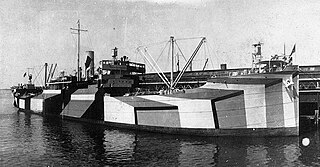
West Compo was a steam cargo ship built in 1918–1919 by Northwest Steel Company of Portland for the United States Shipping Board as part of the wartime shipbuilding program of the Emergency Fleet Corporation (EFC) to restore the nation's Merchant Marine. The vessel was commissioned into the Naval Overseas Transportation Service (NOTS) of the United States Navy in January 1919 and after only one overseas trip was decommissioned four months later and returned to the USSB. Afterwards the vessel was largely employed on the Atlantic Coast of the United States to France route until mid-1921 when she was laid up and eventually broken up for scrap in 1936.
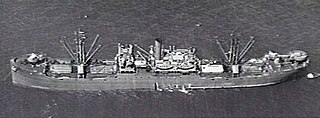
USS West Corum (ID-3982) was a cargo ship for the United States Navy in 1919. The ship was built as SS West Corum and reverted to that name at the end of her Navy service. During World War II, the ship was United States Army transport ship USAT West Corum, later renamed to Will H. Point.
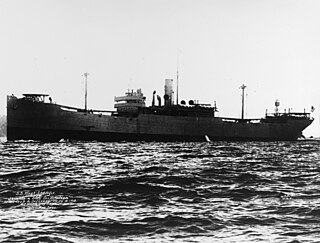
USS West Lianga (ID-2758) was a cargo ship for the United States Navy during World War I. She was later known as SS Helen Whittier and SS Kalani in civilian service under American registry, as SS Empire Cheetah under British registry, and as SS Hobbema under Dutch registry.

USS West Ekonk (ID-3313) was a cargo ship for the United States Navy during World War I. She was later known as SS West Ekonk in civilian service under American registry, and as SS Empire Wildebeeste under British registry.

West Madaket was a steam cargo ship built in 1918–1919 by Skinner & Eddy Corporation of Seattle for the United States Shipping Board as part of the wartime shipbuilding program of the Emergency Fleet Corporation (EFC) to restore the nation's Merchant Marine.

SS West Hosokie was a steel–hulled cargo ship built in 1918 as part of the World War I emergency wartime shipbuilding program organized by the United States Shipping Board.

SS West Gotomska was a steel–hulled cargo ship built in 1918 as part of the World War I emergency wartime shipbuilding program organized by the United States Shipping Board.

SS Edenton was a steel-hulled cargo ship built in 1918 for the United States Shipping Board as part of the Board's World War I emergency shipbuilding program.
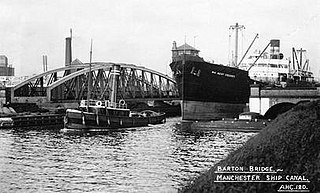
SS West Cressey was a steel-hulled cargo ship that saw a brief period of service as an auxiliary with the U.S. Navy in the aftermath of World War I.

SS West Loquassuck was a steel–hulled cargo ship built for the United States Shipping Board's Emergency Fleet Corporation in World War I. After completion on 15 October 1918, the ship was immediately commissioned into the U.S. Navy as USS West Loquassuck (ID-3638), just weeks before the end of the war.

SS West Mahomet was a steel–hulled cargo ship which saw service as an auxiliary with the U.S. Navy in 1918-19.
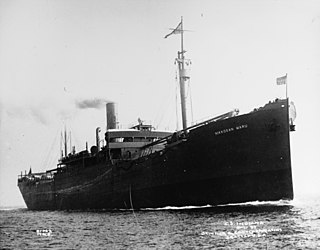
USS Western Front (ID-1787) was a steel-hulled cargo ship which saw service as an auxiliary with the United States Navy in World War I. Initially named Martha Washington, she was laid down for mercantile service as Nikkosan Maru, but following America's entry into the war, was requisitioned by the United States Shipping Board and commissioned into the U.S. Navy as the supply ship USS Indiana. This name was also quickly dropped however, in favour of USS Western Front.

USS West Hobomac was a steel–hulled cargo ship which saw service with the U.S. Navy as an auxiliary during World War I, and which later operated under the British flag during World War II before being lost to enemy action.

SS West Humhaw was a steel–hulled cargo ship built in 1918 as part of the United States Shipping Board's emergency World War I shipbuilding program.
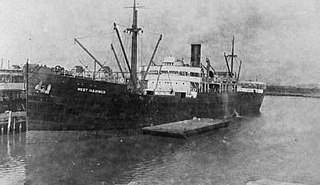
SS West Maximus was a steel-hulled freighter built for the United States Shipping Board's emergency wartime construction program during World War I. Completed too late to see service in the war, West Maximus spent the interwar years in commercial service.




















